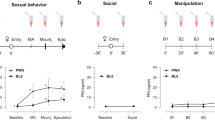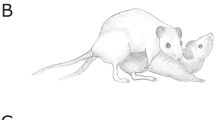Abstract
THE sexual behaviour of higher primates has special relevance to the human situation. The rhesus monkey, for instance, has a true menstruation, and copulation occurs throughout the cycle. Levels of sexual activity, however, are generally higher in the peri-ovulatory period1, and a similar mid-cycle maximum has been reported for certain human couples2. Androgens increase the sexual behaviour of rhesus females3,4, and they have been used to treat loss of libido in women5. These observations, together with the rise in plasma testosterone near mid-cycle, have led to suggestions that androgens may be the main libidinal hormone in the female6. We report here our experiments to test this hypothesis. We devised a daily dose schedule of oestradiol, testosterone and progesterone for ovariectomised rhesus monkeys that duplicated the changing plasma levels during normal menstrual cycles. When males were paired with females so treated, sexual activity showed a pattern similar to that during the normal cycle, and the omission of testosterone was without any detectable effect on this pattern.
This is a preview of subscription content, access via your institution
Access options
Subscribe to this journal
Receive 51 print issues and online access
$199.00 per year
only $3.90 per issue
Buy this article
- Purchase on Springer Link
- Instant access to full article PDF
Prices may be subject to local taxes which are calculated during checkout
Similar content being viewed by others
References
Michael, R. P. & Bonsall, R. W. Nature 265, 463–465 (1977).
Udry, J. R. & Morris, N. M. J. Reprod. Fert. 51, 419–425 (1977).
Herbert, J. & Trimble, M. R. Nature 216, 165–166 (1967).
Wallen, K. & Goy, R. W. Horm. Behav. 9, 228–248 (1977).
Greenblatt, R. B., Mortara, F. & Torpin, R. Am. J. Obstet. Gynec. 44, 658–663 (1942).
Money, J. in Human Sexuality in Four Perspectives, Vol. 3 (ed. Beach, F. A.) 62–86 (Johns Hopkins University Press, Baltimore, 1977).
Michael, R. P., Saayman, G. S. & Zumpe, D. J. Endocr. 41, 421–431 (1968).
Michael, R. P. & Zumpe, D. Anim. Behav. 25, 936–944 (1977).
Michael, R. P., Zumpe, D., Keverne, E. B. & Bonsall, R. W. Recent Prog. Horm. Res. 28, 665–706 (1972).
Kim, M. H., Hosseinian, A. H. & Dupon, C. J. clin. Endocr. Metab. 39, 706–712 (1974).
Everitt, B. J., Herbert, J. & Hamer, J. D. Physiol. Behav. 8, 409–415 (1972).
Author information
Authors and Affiliations
Rights and permissions
About this article
Cite this article
MICHAEL, R., RICHTER, M., CAIN, J. et al. Artificial menstrual cycles, behaviour and the role of androgens in female rhesus monkeys. Nature 275, 439–440 (1978). https://doi.org/10.1038/275439a0
Received:
Accepted:
Published:
Issue Date:
DOI: https://doi.org/10.1038/275439a0
Comments
By submitting a comment you agree to abide by our Terms and Community Guidelines. If you find something abusive or that does not comply with our terms or guidelines please flag it as inappropriate.



